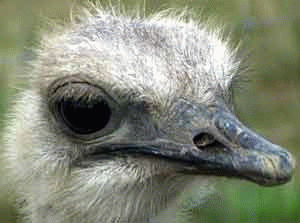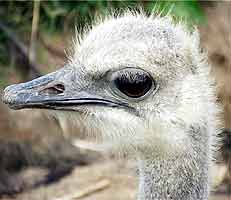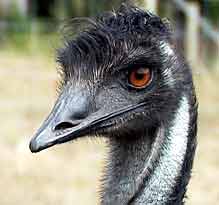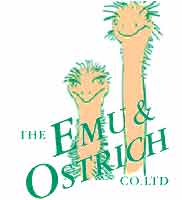 |
Ostriches |
 |
Emus |
 |
Rheas |
 |
History |
 |
Meats |
 |
Quiz |
 |
Shop |
 |
Home |
|
|
The Emu is the
largest bird inhabiting Australia (5.7 feet tall, and weighing
110-120 pounds. Brown in colour; after moulting, new feathers
may appear nearly black, fading to pale brown with age. The bases of
it's feathers are white.
Each feather has two shafts, with barbs so widely
spaced that they do not interlock to form firm vane as in most birds; they
form a loose, hair-like body covering. Feathers growing near base of spine
differ from those covering rest of bird; they have longer barbs and are
set wide apart, giving appearance of a mop-like tail. The skin on the
emu's head and
neck are often free of feathers and have a bluish tinge.
The intensity of this
colour varies according to: (1) season of year; (2) changes in
surroundings; and (3) behaviour of nearby birds. Sexes are similar in
plumage except for the period prior to egg laying when the female's head and neck
are covered with black feathers. Weight of a female is 90 pounds, of a
male is 80 pounds. They have 3 toes; the underside of each toe is
flattened with a broad pad. Two main calls: a gutteral grunt and a
throbbing drum. Found on the grassy plains and dry open forests of Australia,
they eat: Fruits, flowers, insects, seeds and green
vegetation. They love caterpillars. Ingest large stones into
gizzard to aid |
|
|
grinding process
and need water daily. Their nest is a shallow depression next to a bush made with leaves, grass and
bark, and they usually breed in period from May through August. Each male has several
hens, and he incubates the eggs and raises the young. Sitting Does not
begin until 5-9
eggs are laid. The hen lays 9-12 eggs, each weighing 1-1 1/2 pounds. A clutch
can exceed 20 eggs in a good season, down to 4-5 in a poorer season.
|
 |
|
During the 8 weeks
incubation period, the male does not drink, rarely eats, and loses 10-20
pounds. Eggs are dark green, almost black. Chicks are cream in colour with
brown longitudinal stripes and dark dots on the head.. The young leave the nest after 2-3
days, although the male guards the chicks for up to 18 months. Chicks hatched away from
their father do not know how or what to eat. Life span is 5-10 years in the
wild, longer in captivity.Expert
swimmers and fast runners, emus can reach speeds of up to 40 mph for short bursts. Running
birds can make a stride of nine feet. Their bill is broad and
soft, adapted for browsing and grazing. When food is abundant, large
stores of fat are developed. They move great distances for food except
when males are sitting on eggs |
The emu has been resident in Australia for
over 80 million years |
|
|







